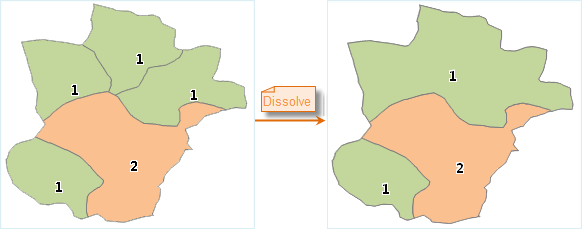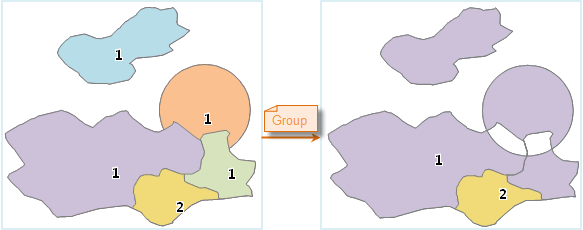Function Description
Merging objects in a line data set, a surface dataset and a text dataset which meet certain conditions into an object. This function applies to line datasets, 2D region datasets, 3D line datasets, and text datasets. For text datasets, the default processing method is Group.
Dataset dissolve must meet the following conditions:
- The values of a certain field are the same between data objects.
- Line objects must have coincident endpoints to be dissolved.
- Region objects must intersect or be adjacent (sharing a common edge).
The dataset dissolve function includes three processing methods: Dissolve, Group, and Group after Dissolving.
- Dissolve:

Dissolve objects numbered 1 As shown above, Dissolve merges multiple sub-objects into a single simple object. Regions numbered 1 are dissolved, but non-adjacent objects are not merged.
- Group:

Group objects numbered 1 into a compound As shown above, Group combines multiple sub-objects into a compound object, where the intersection of objects is processed using an XOR operation.
-
Group after Dissolving:

Group objects with the same number after dissolving into a compound Objects with the same property field value that intersect or are tangent are first dissolved into a simple object. If there are non-adjacent objects with the same merged field value after dissolving, they are further grouped into a complex object.
Function Entry
- Data Tab -> Data Processing Group -> Vector -> Dissolve.
- Toolbox -> Data Processing -> Vector -> Dissolve.
Parameter description
- Source Dataset: Displays all line and region datasets under the selected data source. Select the dataset to be dissolved.
- Dissolve Mode: The system provides three dissolve modes.
- Dissolve: Merges objects with the same property field value that intersect or are within the fusion tolerance range into a single object.
- Group: Groups objects with the same property field value into one object, removing overlapping parts.
- Group after Dissolving: First dissolves objects with the same property field value that intersect or are tangent into a simple object. If non-adjacent objects with the same merged field value exist after dissolving, they are further grouped into a complex object.
- Fusion tolerance: After dissolving, if the distance between two or more nodes is within this tolerance, they are merged into one node. The default value is one-millionth of the dataset's boundary range (maximum tolerance is 100 times the default tolerance), in the dataset's original units.
 Note:
Note:For text dataset dissolve, only the Group mode is supported, and the fusion tolerance cannot be set (meaningless).
- Filter Expression: Only objects meeting this condition participate in the dissolve operation.
- Process objects which have no field values: If checked, objects with empty merged field values participate in the dissolve operation.
- Merged Field: A field in the dataset where objects with the same field value are dissolved or grouped based on this field.
- Statistic Field: Performs field statistics on dissolved objects (generating new fields to store statistical values). Statistics types include Max, Min, Sum, Average, First Object, Last Object, and Text Link.
- Max: Calculates the maximum value of the field for dissolved/grouped objects. Valid only for numeric and time fields.
- Min: Calculates the minimum value of the field for dissolved/grouped objects. Valid only for numeric and time fields.
- Sum: Calculates the sum of the field for dissolved/grouped objects. Valid only for numeric fields.
- Average: Calculates the average value of the field for dissolved/grouped objects. Valid only for numeric fields.
- First Object: Obtains the field value of the object with the smallest SmID in the dissolved/grouped objects.
- Last Object: Obtains the field value of the object with the largest SmID in the dissolved/grouped objects.
- Text Link: Obtains a string of field values from dissolved/grouped objects connected by semicolons (;). Valid only for text fields. Application scenario: A highway dataset contains an administrative division field. During dissolve, the field values can be connected with semicolons to indicate which administrative divisions the highway passes through.
 Note:
Note:When using this type, the merged field must be set, and the merged field values of text link objects must be the same.
- Preserve the table structure of the source dataset: If checked, preserves the table structure of the source dataset, meaning all other fields not selected as merged or statistic fields are retained, and their values are empty.
- Result Data: Name and save the dissolved result dataset, and select the data source where the dataset is located.
 Note:
Note:When the merged field values are the same, if three or more line segments have endpoints coinciding at one point, the system will not perform the dissolve.
Related Topics



